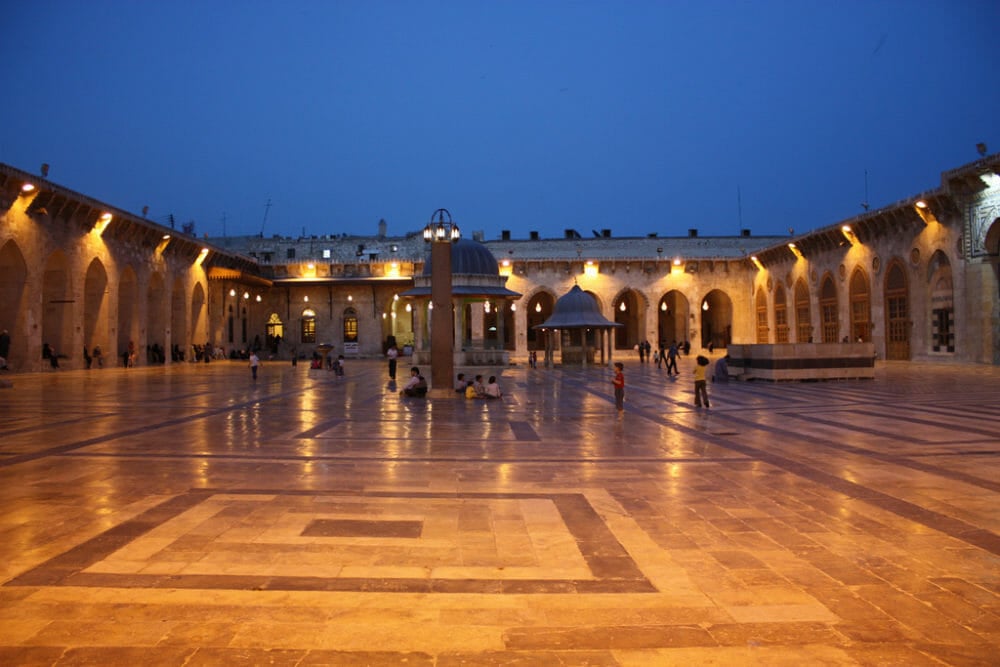Revolutionaries for Hire
How the Leon Sedov Brigade joined the Syrian civil war Aleppo's Great Mosque. | Arian Zwegers
Aleppo's Great Mosque. | Arian Zwegers o
r
d
F
a
c
t
o
r
y
On May 1?I went out to the Worker’s Day parade in Milan. It was supposed to be a day of unity and celebration. Instead, I saw people who shared the same political culture and almost the same political affiliation clash violently over the Syrian flags they were waving: the Assadists with the red, white, and black flag of the Syrian government started a fight with some pro-Kurdish activists who carried the yellow banner of Rojava—the Kurdish-led Democratic Federation of Northern Syria—calling them traitors and imperialists. And then, all of a sudden, both groups stopped fighting each other and turned their attention on a common enemy, the green flag of the Free Syrian Army, carried by some staunch supporters of the country’s 2011 revolution.
It was a good reflection of the chaos the international Left is in when it comes to Syria. The Syrian civil war has split the Left in two: there is the so-called anti-imperialist left, which is more or less critically supporting the Assad regime against a perceived “imperialist aggression” carried out by foreign-funded jihadi groups, all the while erasing the role played by the regime itself in the crisis; and then there is the anti-authoritarian, anarchist Left which is embracing the democratic and egalitarian project of the Kurds in Rojava, with their brave female fighters and their relentless charge against the Islamic State.
Some of them are now living in Idlib, others went back home, undercover for fear of being prosecuted as foreign fighters and only God knows where they are now.
These two sides are open enemies but there is one thing they agree on: the Syrian revolution, if there ever was such a thing, is a failed project. Maybe the 2011 protests were real and spontaneous, they say, but the revolution died in its cradle at the start of the uprising. The Free Syrian Army, just like all the Islamist militias who gradually replaced it, has been a proxy force ridden by corruption, a loose association of commanders fighting for their own interests, bankrolled by foreign powers with little interest in the Syrian people’s freedom or “karama”—dignity in Arabic.
One of the factions who don’t see things this way are the members of a small, almost unknown group of communist fighters called the Leon Sedov Brigade. Founded by a group of five to ten young guys from Argentina, all desperate to aid the revolution, the brigade counted more than two hundred fighters at its peak, almost all Syrians, according to Abu Muad, a member of the Brigade I spoke with via Skype in May. The Brigade fought against the Syrian opposition and the Kurdish YPG (People’s Protection Units); they remained committed to the Syrian revolution until the very end. Besieged in Aleppo, they aided an attempt to literally seize the means of production, by supporting workers at a factory in Urem al Kubra, to start a new October revolution. Nearly a dozen of them died in the battle for Aleppo and when the Assad regime recaptured the city in December 2016, the survivors surrendered, were bussed to Idlib, or fled the country, the only options left to those fighting Assad’s forces. Some of them are now living in Idlib, the last Syrian territory still controlled by the rebels; others went back home, undercover for fear—real or imagined—of being prosecuted as foreign fighters and only God knows where they are now.
Leon Sedov, the group’s namesake, was born in St. Petersburg in 1906 and died in Paris in 1938. To not be seen as privileged, like many sons of famous fathers do, he used his mother’s name. His father was Leon Trotsky, Lenin’s most trusted comrade, who created the Red Army and won the Russian Civil War only to be dismissed, exiled and later killed by Stalin. Leon Sedov, to those who admired him then and now, was an activist who died in mysterious circumstances, involving acute appendicitis and an agent in the NKVD (Stalin’s secret service) who posed as his friend.
More

Syriana | Max B. Sawicky
By Max B. SawickyFor Muad—who asked me to use his nom de guerreinstead of his real name—a twenty-three-year-old teacher from Argentina and an affiliate of the South American Trotskyist organization Fracción Leninista Trotskista Internacional (FLTI), Leon Sedov was a hero. At the start of the Arab Spring, Muad decided to do what he considered following in Sedov’s footsteps. He went to Libya with a group of friends to fight with Libyan rebels against the Gaddafi regime. Later they adopted the name Leon Sedov Brigade. After seeing how quick and successful that revolution had been, they decided to keep fighting in what they viewed as a single revolution spreading across all of Middle East. So they embarked for southern Turkey, crossed the porous Syrian border and headed for Aleppo.
Muad and his comrades followed an old but relevant blueprint: Trotsky’s main contribution to Marxism was his theory of the permanent revolution. He stated that a democratic revolution led by the bourgeois can’t succeed by itself—at one point it has to face problems that it can solve only by evolving, it has to mutate to become a socialist revolution. A revolution within a revolution is needed, as that is the only way to achieve the goals of a democratic revolution. Then the road is open and the working class can travel upon it, how far depending on the course of the events. This revolution within a revolution, Trotsky wrote, is particularly true for “backward,” or underdeveloped countries. Just like Syria, some would say.
In the months prior to July 2012, Syria was already burning but Aleppo was relatively quiet. But by mid-July FSA and other rebel groups had penetrated the city, conquering the eastern working-class neighborhoods. Muad and his friends joined the local coordination committees and started to recruit people into their group. “We couldn’t say we were communists, we couldn’t even utter the word ‘socialism’ because among the Syrians it had become a bad word. Assad’s Ba’ath party claimed to be socialist. They saw so-called socialists torturing and killing people,” he told me. So the Brigade put words aside and decided to demonstrate their commitment to the people with their actions. They would live among the people, working in factories and construction sites in the city, making friends and helping their neighbors until the day they could talk about Marx and Lenin and be listened to.
He wears a military jacket, holds an AK-47 in his left hand and stares silently at the camera. The only sound you hear is the wind.
That was good praxis. For four years, from 2012 to 2016, nearly half of Aleppo city was controlled by the rebels—led at first by the FSA and later by jihadi groups such as the al-Nusra Front, the then al-Qaeda branch in Syria—and the Leon Sedov Brigade slowly grew in numbers. Unlike almost all other militias they received no funding from foreign powers, Muad told me, and they refused to finance themselves with crime and corruption. Instead, they worked regular jobs, investing their wages in weapons and bullets. They also tried to be as democratic as is possible in a war zone, electing their commanders and discussing and voting before taking any military action. They were loved by the people, Muad told me, but they were hated by other rebel groups.
“Right from the start we had problems with them,” Muad told me when I asked him about the group’s relations with the other Syrian rebels. “We saw that the FSA was trying to disarm the people and control the revolution. They set checkpoints in order to control the transportations and commerce in the city. They imposed taxes on the population saying that it would serve to support their fight against the regime,” Leonardo Hofstadter, a member of the Brigade, told me. But at the same time, Muad explained, in Aleppo’s liberated areas they acted like a private police force rather than truly fighting the regime.
To Muad, the regime and the rebels where almost two faces of the same coin, using different methods to achieve the same goal. So the Brigade tried to stop them. They started organizing the workers of the city, trying to set up unions in factories and construction sites, calling for demonstrations and strikes, often clashing with the FSA and the other militias in the process. When the workers of a big textile factory in the town of Urem al-Kubra in the Aleppo countryside, tired of working thirteen hours for roughly $1 a day, they decided to occupy the factory. The Leon Sedov Brigade was the only militia to support and protected the workers. “It was the start of a socialist revolution,” Muad told me, “the workers were seizing the means of production and using it for the revolution.” It didn’t last long. Muad speculates they were warned by the FSA and the regime’s planes subsequently bombed and destroyed the factory.
The Brigade’s dream of a permanent revolution began to collapse in July 2016, when the last supply line into rebel-held Aleppo was cut by the Syrian army and pro-regime forces. It was the start of “the mother of all battles,” as the rebels called the siege of Aleppo. The situation was already critical. “At the start the people of the city wanted to fight the regime, they wanted to at least try to break the siege,” Leandro Hofstadter told me. “But the rebels were doing nothing. The people even demonstrated outside one of their headquarters asking them to give them weapons to fight, but they didn’t.”
There is a video from those Aleppo days on YouTube. It’s recorded with a cellphone and judging from the light it looks like early morning. It shows a guy with long, dark hair and an unkempt beard sitting with others in the back of a pick-up rolling down an empty road, destroyed buildings on both sides. He wears a military jacket, holds an AK-47 in his left hand and stares silently at the camera. The only sound you hear is the wind. The guy’s name was Abu al-Baraa. He was Syrian, he was the unofficial leader of the Leon Sedov Brigade. Before the war broke out he was studying economics at Aleppo University. He was only twenty-four when he died.